|
History
of WKRN-TV
WKRN-TV began operation on Sunday, November 29, 1953 at 1:00 p.m., as only
the second television station in Nashville. The station's call letters and channel number were WSIX-TV Channel 8. It was a
CBS affiliate with supplemental affiliations with American Broadcasting Company and the DuMont Television Network. In late
1954, it became a full time ABC affiliate and continues that affiliation today. WSIX-TV was owned and operated by Louis Draughon,
a native of Springfield, Tennessee. He, along with his brother, Jack Draughon, had started WSIX-AM/FM Radio. The television station's first studio was located at its transmitter on Old Hickory
Boulevard in the outskirts of Nashville, referred to as "The Hill." The station's business office, along with WSIX
Radio were on the 14th floor of the Nashville Bank & Trust Building in downtown Nashville. The tower used was the one previously occupied by WSIX-FM radio. The FM station had
operated from 1948 until it went off the air in 1953. The FM operation had been unprofitable, and television was expected
to be a better use of the facility. The initial operation was with a power of 109 KW at a height of 247 feet above ground,
1365 feet above sea level. In December 1955, WSIX-TV began operation at 178KW with a 12 bay bat-wing antenna and with a new
tower. The new tower put the station antenna at 2049 feet above sea level. In October 1957 WSIX-TV applied for a power increase
to 316KW using the existing antenna facility. In
1961 WSIX-TV, WSIX-AM & FM (now back on the air) moved to 40 acres of prime industrial land on Murfreesboro Road in Nashville.
The same location where WKRN-TV operates today. Archie Boone, father of entertainer Pat Boone, was the contractor hired to
build the facility. The state of the art facility was competitive with studios in New York and Los Angeles and became the
hub of television production in the central region of the country. Louis Draughon sold WSIX-TV and the two radio stations to General Electric Broadcasting on May 19, 1966. On December
11, 1973 at 9:00pm WSIX-TV (Channel 8) exchanged channels with WDCN-TV (Channel 2), the PBS affiliate in Nashville. When this
exchange was made WSIX-TV started operating as WNGE (W-Nashville-General-Electric) Channel 2. This was with a new, stacked
Channel 2 and Channel 8 antennas a top a new tower. This was only the third exchange in the history of commercial television
in the United States. A two-minute videotape, featuring Robert Young of Marcus Welby series, Big Bird of Sesame Street and
The Electric Company's Easy Reader aired introducing the switch. WNGE-TV changed ownership from General Electric Broadcasting to Knight-Ridder Broadcasting on November 28, 1983.
WSIX radio stations were sold to Sky Communications of New York. Knight-Ridder changed the call letters to WKRN-TV (W-Knight-Ridder-Nashville).
Young Broadcasting, Inc. acquired WKRN-TV from Knight Ridder Broadcasting on July 1, 1989 and is the current owner.
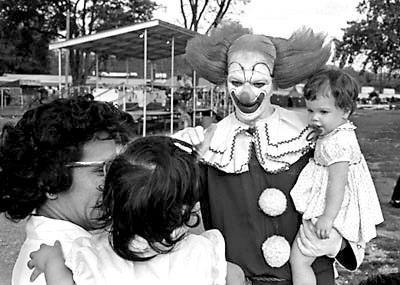
|
| Jim Kent was Bozo the Clown on WSIX-TV |
In the early years of the station, daily sign-on
was not until 9:45am and local programming filled much of the airtime. Many of the people who worked for WSIX Radio, became
on-air television personalities. The many hours of local weekly programming meant that the station's staff had to come
up with ideas and produce shows using station talent. Some of these local talents were seen on-air many hours each day. When
WSIX-TV went on the air, the faces of Ken Bramming, Hugh Cherry, Jim Kent, Noel Ball and many others quickly became well know
to viewers in Middle Tennessee. WSIX-TV produced many local programs, such as Saturday Showcase, Romper Room, Bop Hop, Shock
Theatre, Classroom Olympics, Lucky Video, Mickey Mouse Club, to name a few. Network programming in the early years included a variety of programs such as I Love Lucy, Jackie
Gleason, Ed Sullivan, 77 Sunset Strip, Adventures of Ozzie and Harriet, The Betty White Show, The Cisco Kid, The Donna Reed
Show and many more. Historically, WKRN has always
been committed to regional news coverage. In the early 1960's it became the first station in Nashville to air a 5:00pm
newscast. In 1998, the station's weather coverage of the tornado that ripped through downtown Nashville was seen around
the world on CNN. News personalities such as Jackie Joyner and Hudley Crockett paved the road to news excellence that continues
today. The station has been recognized for its news coverage with numerous awards and honors including Midsouth Emmy's,
Peabody Awards, Edward R. Murrow Awards and many more. Community
involvement has always been a top priority to WKRN throughout its history. From the early days of Toys For Tots and UCP Telethon
to its current community efforts with Food 2 Family and Ronald McDonald House "Calls For Kids", WKRN continues to
have a strong presence in the community. The station's
humble beginnings paved the way for years of news excellence, quality programming and community involvement. WKRN has made
changes through the years and you've changed with us. We're proud of our history and service to Middle Tennessee and
Southern Kentucky.
[History courtesy of WKRN.com]
|
 |
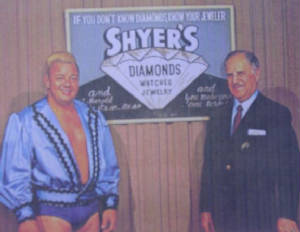
|
| The "Fabulous One"---Jackie Fargo with Harold L. Shyer |
Live studio
wrestling was a popular early program on WSIX-TV. Sponsored by Harold L. Shyer Jewelers ("If you don't know diamonds,
know your jeweler...and if Harold says it's so, it's so"), early performers included the Fargo brothers, the
Greene brothers, the Germans and their manager, "Gentleman" Saul Weingeroff, Tojo Yamamoto and others. Promoted
by the popular Nick Gulas, many Nashvillians remember the night things got out of control in the WSIX-TV studio and a female
fan got so angry with the villainous Jackie Fargo that she took off her high-heeled shoe and when he jumped out of the ring,
she hit him over the head with it.
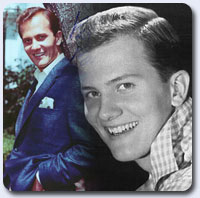
|
| Pat Boone in the 1950's in Nashville |
Pat Boone
grew up in Nashville and sang in local talent shows, appearing frequently at the Happiness Club at the Belle Meade Theater.
His father was the contractor for the building that housed WSIX-TV on Murfreesboro Road, and Pat often sang on the television
station in its early days on the air.
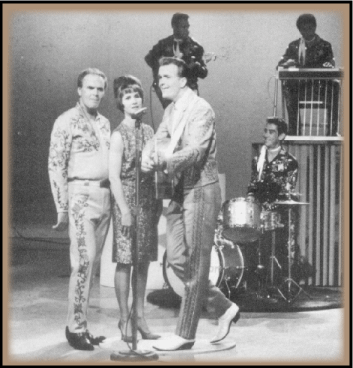
|
| Bill Anderson and Jan Howard on WSIX-TV |
|
|
 |
 |
| Shock Theater photo courtesy ChillerCinema.com |
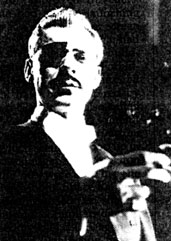
|
| Ken Bramming as Dr. Lucifur |
|
 |
|
Dr. Lucifur On WSIX-TV
by Jeff Thompson, ChillerCinema.com
“He was a very elegant gentleman who had been the
president of Transylvania for the past two hundred years. He spent a lot of time looking down his nose at people.” This
is how Nashville broadcaster Ken Bramming (1926-1997) fondly remembered his horrific alter-ego, Dr. Lucifur, Nashville’s
first TV horror-movie host. Bramming, the sonorous-voiced television and radio personality, hosted Shock Theater on Nashville’s
WSIX-TV 8 (now WKRN-TV 2, then and now an ABC affiliate) from November 1958 until April 1967. The show originally aired on
Friday nights at 10:15 PM CST—“That was in the days of the fifteen-minute newscast,” Bramming remarked—and
later moved to Saturday nights at 10:30. “We knew we’d get a young audience on those nights,” Bramming said.
“We were aiming for the ten- to fourteen-year-olds, but their parents ended up watching the show with them and liking
it as much as the kids!”
In the early months, Shock Theater
opened with Modest Moussorgsky’s “Night on Bald Mountain” as its theme song and with Ken Bramming’s
live, “straight-voice” (non-character-voice) announcement of that night’s movie. Shock Theater’s cinematic
fare ranged from the classic Universal monster movies to the Sherlock Holmes and Mr. Moto mysteries to a few science-fiction
titles. Bramming himself selected and prepared every film.
In
the summer of 1959, seven months after Shock Theater’s debut, Bramming decided to liven up the show by adding a ghoulish
on-camera host—played by himself. Bramming created the character of Dr. Lucifur from an amalgam of “Bela Lugosi’s
Dracula, some of John Carradine’s characters, and some Vincent Price things.” Bramming’s Lucifur, who always
appeared in black-and-white even if the night’s film was in color, was a striking figure. The dapper Transylvanian sported
silver hair, a black eyepatch over his right eye, a Ming moustache, and a cigarette holder. He dressed elegantly in white
tie and black tails and a flowing black cape, and he spoke with a Transylvanian accent. The “Night on Bald Mountain”
theme soon was replaced by “Blues for Lucifur,” a jazzy electric-guitar melody composed and performed by Nashville
musician Norm Cole. As the theme played, a wavy circle—“We called it the Mystic Circle,” Bramming explained—appeared
on the TV screen and framed Dr. Lucifur, who walked into a pool of light near a lamppost. Fog swirled around the devilish
doctor as he greeted the viewers and urged them to come with him on “these journeys into the worlds of mystery, the
supernatural, fantasy, and the world beyond.” At the conclusion of the film, Dr. Lucifur reappeared, invited the viewers
back next week, and (with “a wild laugh”) said, “Good night—and pleasant dreams!”
This atmospheric “intro and outro” featuring Bramming as Lucifur was on
film; therefore, Bramming was free to appear as himself or as other characters in the five live breaks in the course of that
night’s film. Dr. Lucifur rarely appeared on-camera in those five breaks although his rich voice was heard whenever
the camera suddenly became Lucifur’s “eyes” and showed subjective shots of other people talking to “him”
(the camera). Those people—or sometimes creatures!—who interacted with Lucifur and each other ranged from a demented
grandmother and a comical beatnik to a wacky poet and a reanimated mummy. While Ken Bramming played Dr. Lucifur off-camera
or a man-on-the-street interviewer on-camera, his several assistants portrayed Shock Theater’s other recurring characters.
“My top assistant,” Bramming recalled, “was
Corky Savely, a mad genius who was still in high school at the time. He would dress up as a character named Granny Gruesome,
who one night showed the viewers how to knit a sports car out of 1500 pounds of steel wool. Corky also dressed as Frantic
Freddy the Hipster or Cyril Songbird the Poet—that one we stole directly from Ernie Kovacs!—and Corky would dress
up like a mummy whenever we showed a mummy movie. Other characters were played by Herschell Martin and Richard Dixon, and
Norm Fraser played the ‘infamous’ Baron Von Sloucho. We did crazy things, and the show had no time limit. Sometimes,
our breaks in the movie lasted ten minutes!”
Except for
Corky Savely’s mummy appearances and a few other tie-ins, Bramming and company’s live, ad-libbed routines during
the movies were completely unrelated to the films. “We did take-offs of popular songs like ‘Monster Mash’
and ‘Tom Dooley,’ and we spoofed many TV commercials and TV series. We did a take-off of ‘The Loretta Young
Show’ called ‘The Forever Young Show.’ Miss Forever Young’s famous doors were stuck, and she couldn’t
get them open to make her entrance. We even did a take-off of ‘Batman’ when the TV show was popular—only
we had [Nashville restaurateur] Mario Ferrari dressed as Batman and speaking Italian!”
An instance when Bramming appeared on-camera as Dr. Lucifur during the comical breaks in the movie
occurred in the autumn of 1960. At the same time that New York TV horror-movie host Zacherley was running for President of
the United States, Dr. Lucifur ran for re-election to the presidency of Transylvania. Having held the office for the past
two centuries, the arrogant aristocrat figured that he was a shoo-in for re-election. However, in a last-minute upset, Lucifur’s
opponent Granny Gruesome was elected instead!
These and many
other zany stunts catapulted WSIX-TV’s Shock Theater through the ratings belfry. “Between 1958 and 1962,”
Bramming revealed, “we were rated number one in Nashville in that Friday- or Saturday-night timeslot. We beat the ‘Tonight’
show on NBC and whatever was on CBS. Shock Theater was a family show. The movies weren’t really scary, and there was
never any blood and gore in the movies or in our segments. I insisted on that. We were there to have fun. I never received
any bad mail from parents. Instead, I got letters from parents telling me how much they liked watching the show with their
kids. There were things for the adults to like, such as the jazz background music of our segments. I used nice things that
the adults and I dug by people like [guitarist] Wes Montgomery, the Paul Smith Trio, and the Dave Brubeck Quartet.”
| photo courtesy of ChillerCinema.com |
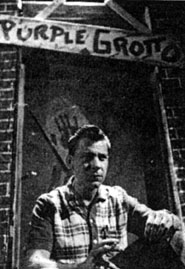
|
| Ken Bramming as he really looked |
Ken Bramming and his campy compatriots accomplished their
live routines with a minimum of sets and props. Dr. Lucifur’s lamppost regularly reappeared as a set dressing for Bramming’s
man-on-the-street interviews with Frantic Freddy, Mrs. Moshe Gumora, the Poor Slob, and other characters. “We often
used fog for background,” Bramming continued. “The crew at WSIX made a dry-ice fog machine for us. When we did
a take-off on ‘Tom Dooley,’ we went into the next studio, where the wrestling ring was, and used one corner of
the ring for Tom Dooley’s gallows. But our best set was the Purple Grotto, a purple, cave-like flat with a door in it.
The door had bloody handprints on it. One night, the whole Purple Grotto flat fell forward in the middle of our skit! We were
live, so there was nothing we could do. That reminds me of another blooper. I often would do live commercials as myself, and
one of our sponsors was a man named Fred Mabius, who installed glass shower enclosures. I was standing next to a four-sided
shower enclosure [and] doing a commercial for it when the thing fell over and shattered into a million pieces. I looked at
the camera and said, ‘Now, friends, if Fred Mabius had installed it, that wouldn’t have happened.’ We quickly
went back to the movie after that because the crew was breaking up!
“Television was brand-new,” Bramming continued, “and we did some funny things.” Sadly,
because all of Bramming’s skits were performed live, no films or tapes of them exist. The only footage of Bramming as
Lucifur is the black-and-white, filmed “intro and outro.”
By 1967, although Shock Theater’s ratings were still good, both Ken Bramming and WSIX-TV felt that
the Saturday-night show had run its course. Bramming left WSIX and took a radio-announcing job, but Dr. Lucifur and the Mystic
Circle were back on the air in Music City just a year-and-a-half later. Between October 1968 and November 1969, Bramming,
as Lucifur, hosted a weekend horror movie on WMCV-TV 17, an independent station. When Channel 17 threw a Halloween party for
children in October 1968, Ken Bramming and Corky Savely were on hand as Lucifur and the mummy. This was Dr. Lucifur’s
third personal appearance: during the WSIX days, Bramming had appeared in costume at two Nashville department stores. “And
the kids climbed all over me!” Bramming laughed.
After
his Lucifur years, Ken Bramming re-connected with his horror roots when he served as the pre-recorded announcer for Creature
Feature, a Saturday-night horror movie telecast on WSM-TV 4 (NBC) in the early 1970s. The host of Creature Feature was Sir
Cecil Creape (Russ McCown, who went on to play the Phantom of the Opry on The Nashville Network). Bramming’s unmistakable
voice at the beginning of Creature Feature provided a link between the two horror hosts as did Sir Cecil’s occasional
mentioning of his friend Dr. Lucifur, thereby acknowledging that Nashville’s horror hosts existed in the same universe.
Bramming even made one on-camera appearance as Lucifur in an episode of Creature Feature, which each week was scripted by
WSM weatherman Pat Sajak, years before he too became a noted TV host.
Dr. Lucifur’s latter-day radio incarnations in the 1970s, 1980s, and 1990s included his voicing a safe-driving
public-service announcement for the Tennessee Department of Safety (“Don’t spill your blood on the highway!”)
and his annual resurrection on Halloween to host a broadcast of Orson Welles’s 1938 War of the Worlds radio drama on
WAMB-AM 1200, Nashville’s big-band/easy-listening station. Bramming was the mid-day announcer and program director at
WAMB from 1979 until 1997.
The first annual
World Horror Convention was held in Nashville in 1991, and both Ken Bramming and Russ McCown were there. The horror hosts
appeared together in a panel discussion about their years as Dr. Lucifur and Sir Cecil Creape, and each man re-created his
character’s distinctive laugh for the delighted audience. The horror-hosts panel was a once-in-a-lifetime event, for
McCown died several years later—and Bramming, a lifelong smoker, succumbed to lung cancer in mid-1997. In the late 1990s
and continuing to the present, Dr. Gangrene (Larry Underwood), Nashville’s next great horror host, began keeping Lucifur
and Creape alive by mentioning them on his award-winning horror-movie show, Chiller Cinema, later renamed Creature Feature,
and on his Internet website.
Despite the passing
of Ken Bramming, the immortal Dr. Lucifur lived again on Nashville television on Thanksgiving night 2003 and 2004. In 2003,
WKRN-TV 2 celebrated its fiftieth anniversary with a documentary, an all-day Thanksgiving cornucopia of classic TV shows,
and a new edition of Shock Theater. That night at 10:30, Dr. Lucifur once again strolled up to the lamppost and welcomed viewers
before Channel 2 showed The Brain That Wouldn’t Die. On Thanksgiving night 2004, Dr. Lucifur’s “intro and
outro” began and ended a telecast of House on Haunted Hill.
In October 2006, the independent documentary film American Scary premiered at the Hollywood Film Festival.
American Scary traced the rich history of mid-century TV horror hosts, from Zacherley, Ghoulardi, and Vampira to Dr. Lucifur,
Sir Cecil Creape, and Dr. Gangrene, and it revealed how the horror-host legacy lives on today through public-access television,
video and DVD, and Internet websites. Although his innovative live skits now exist only in the fond memories of long-ago viewers,
Dr. Lucifur, Nashville TV’s tasteful Transylvanian, will live forever.
[visit Jeff's website for more by clicking here]
|
|

